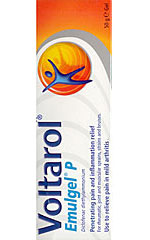 Ingredients
Ingredients- Diclofenac diethylammonium
- Diethylamine
- Carbomer
- Macrogol cetostearyl ether
- Cocoyl caprylo-caprate
- Isopropyl alcohol
- Liquid paraffin
- Perfume
- Propylene glycol
- Purified water
Published October 2010
This is a rubbing gel which claims to deliver "penetrating pain and inflammation relief". It is also available as a tablet although with a different formulation.
Ingredients
Diclofenac diethylammonium (chemical formula C6H3Cl2NHC6H4CH2CO2H) is a type of medication known as an NSAIDs (non-steroid anti-inflammatory drug) and these offer relief by blocking certain enzymes. The diclofenac molecule consist of two benzene rings joined via a nitrogen atom and attached to the benzene rings are two chlorine atoms and an acetic acid group. (The diethylammonium part is there to neutralise the acid group.) The diclofenac blocks the cyclo-oxygenases enzymes (aka COX-2) which produce the prostaglandins that trigger pain and cause inflammation. Moreover, it does not block the related COX-1 enzymes which protect the lining of the stomach and intestines.
Diethylamine (chemical formula (CH3CH2)2NH) is made from alcohol and ammonia and it has a urine-like smell. It is used in the manufacture of rubber, dyes, pesticides, and pharmaceuticals. Here is ensures that all of the diclofenac remains non-acidic. In conjunction with salicylic acid it is the active ingredient in older treatments for rheumatism such as Deep Heat rub.
Carbomer is added as a thickening agent and emulsifier to help the other ingredients to blend smoothly together. It is a polymer of acrylic acid cross-linked with sugar molecules. Acrylic polymers are the basis of plastics like Perspex and are used in paints.
Macrogol cetostearyl ether consists of polyethylene glycol (this consists of long chains of chemical formula -(OCH2CH2)n)- to which are attached fatty alcohols. It make an ideal base chemical for ointments because, like carbomer, it blends well. Polyethylene glycol is used to preserve historic wooden shipwrecks that have been raised from the sea like Henry VIII's Mary Rose.
Cocoyl caprylocaprate consists of saturated fatty acids with 8 or 10 carbon atoms in their chain, linked to fatty alcohols with 12 to 18 carbon atoms in their chains. This also acts as a useful base ingredient.
Isopropyl alcohol (aka isopropanol, chemical formula (CH3)2CHOH)) is a solvent for oily ingredients like cocoyl caprylocaprate, and it is used industrially in its own right as a solvent, as well as being in windscreen washers and de-icing sprays.
Liquid paraffin is a mixture of hydrocarbons distilled from crude oil and it is a collection of similar molecules with 15–40 carbon atoms in the chain. It is used in hydraulic fluids, wood preservatives, baby oils, cosmetics, and lava lamps. Although previously taken to relieve constipation, liquid paraffin has been discontinued because it can interfere with the absorption of oil-soluble vitamins such as A, D and E.
Propylene glycol (aka 1,2-propanediol, chemical formula CH3CH(OH)CH2OH) is a good solvent for keeping all the other ingredient suspended in the gel. Propylene glycol is commonly used as antifreeze.